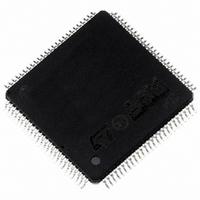ST92F150CV1TB STMicroelectronics, ST92F150CV1TB Datasheet - Page 217

ST92F150CV1TB
Manufacturer Part Number
ST92F150CV1TB
Description
MCU 8BIT 128K FLASH 100TQFP
Manufacturer
STMicroelectronics
Series
ST9r
Datasheet
1.ST92F150CV1TB.pdf
(429 pages)
Specifications of ST92F150CV1TB
Core Processor
ST9
Core Size
8/16-Bit
Speed
24MHz
Connectivity
CAN, EBI/EMI, I²C, LIN, SCI, SPI
Peripherals
DMA, LVD, POR, PWM, WDT
Number Of I /o
77
Program Memory Size
128KB (128K x 8)
Program Memory Type
FLASH
Eeprom Size
1K x 8
Ram Size
4K x 8
Voltage - Supply (vcc/vdd)
4.5 V ~ 5.5 V
Data Converters
A/D 16x10b
Oscillator Type
Internal
Operating Temperature
-40°C ~ 105°C
Package / Case
100-TQFP, 100-VQFP
Processor Series
ST92F15x
Core
ST9
Data Bus Width
8 bit, 16 bit
Data Ram Size
6 KB
Interface Type
CAN, I2C, SCI, SPI
Maximum Clock Frequency
24 MHz
Number Of Programmable I/os
80
Number Of Timers
5 x 16 bit
Operating Supply Voltage
4.5 V to 5.5 V
Maximum Operating Temperature
+ 105 C
Mounting Style
SMD/SMT
Development Tools By Supplier
ST92F150-EPB
Minimum Operating Temperature
- 40 C
On-chip Adc
16 bit x 10 bit
Lead Free Status / RoHS Status
Lead free / RoHS Compliant
Other names
497-4883
Available stocks
Company
Part Number
Manufacturer
Quantity
Price
Company:
Part Number:
ST92F150CV1TB
Manufacturer:
STMicroelectronics
Quantity:
10 000
- Current page: 217 of 429
- Download datasheet (8Mb)
MULTIPROTOCOL SERIAL COMMUNICATIONS INTERFACE (Cont’d)
10.5.5 Serial Frame Format
Characters sent or received by the SCI can have
some or all of the features in the following format,
depending on the operating mode:
START: the START bit indicates the beginning of
a data frame in Asynchronous modes. The START
condition is detected as a high to low transition.
A dummy START bit is generated in Serial Expan-
sion mode. The START bit is not generated in
Synchronous mode.
DATA: the DATA word length is programmable
from 5 to 8 bits, for both Synchronous and Asyn-
chronous modes. LSB are transmitted first.
PARITY: The Parity Bit (not available in Serial Ex-
pansion mode and Synchronous mode) is option-
al, and can be used with any word length. It is used
for error checking and is set so as to make the total
number of high bits in DATA plus PARITY odd or
even, depending on the number of “1”s in the
DATA field.
ADDRESS/9TH: The Address/9th Bit is optional
and may be added to any word format. It is used in
Figure 110. SCI Character Formats
(1)
(2)
(3)
# bits
states
Not available in Synchronous mode
Not available in Serial Expansion mode
LSB First
and Synchronous mode
START
1
MULTIPROTOCOL SERIAL COMMUNICATIONS INTERFACE (SCI-M)
(2)
5, 6, 7, 8
DATA
(1)
PARITY
NONE
EVEN
ODD
0, 1
both Serial Expansion and Asynchronous modes
to indicate that the data is an address (bit set).
The ADDRESS/9TH bit is useful when several mi-
crocontrollers are exchanging data on the same
serial bus. Individual microcontrollers can stay idle
on the serial bus, waiting for a transmitted ad-
dress. When a microcontroller recognizes its own
address, it can begin Data Reception, likewise, on
the transmit side, the microcontroller can transmit
another address to begin communication with a
different microcontroller.
The ADDRESS/9TH bit can be used as an addi-
tional data bit or to mark control words (9th bit).
STOP: Indicates the end of a data frame in Asyn-
chronous modes. A dummy STOP bit is generated
in Serial Expansion mode. The STOP bit can be
programmed to be 1, 1.5, 2, 2.5 or 3 bits long, de-
pending on the mode. It returns the SCI to the qui-
escent marking state (i.e., a constant high-state
condition) which lasts until a new start bit indicates
an incoming word. The STOP bit is not generated
in Synchronous mode.
(3)
ADDRESS
OFF
0, 1
ON
(2)
1, 1.5, 2, 2.5,
STOP
1, 2, 3
(2)
16X
1X
217/429
9
Related parts for ST92F150CV1TB
Image
Part Number
Description
Manufacturer
Datasheet
Request
R

Part Number:
Description:
BOARD PROGRAM FOR ST92F150 MCU
Manufacturer:
STMicroelectronics
Datasheet:

Part Number:
Description:
BOARD EVALUATION FOR ST9 SERIES
Manufacturer:
STMicroelectronics
Datasheet:

Part Number:
Description:
BOARD EMULATOR FOR ST9 SERIES
Manufacturer:
STMicroelectronics
Datasheet:

Part Number:
Description:
MCU, MPU & DSP Development Tools ST9 Dedication Board
Manufacturer:
STMicroelectronics
Datasheet:

Part Number:
Description:
STMicroelectronics [RIPPLE-CARRY BINARY COUNTER/DIVIDERS]
Manufacturer:
STMicroelectronics
Datasheet:

Part Number:
Description:
STMicroelectronics [LIQUID-CRYSTAL DISPLAY DRIVERS]
Manufacturer:
STMicroelectronics
Datasheet:

Part Number:
Description:
BOARD EVAL FOR MEMS SENSORS
Manufacturer:
STMicroelectronics
Datasheet:

Part Number:
Description:
NPN TRANSISTOR POWER MODULE
Manufacturer:
STMicroelectronics
Datasheet:

Part Number:
Description:
TURBOSWITCH ULTRA-FAST HIGH VOLTAGE DIODE
Manufacturer:
STMicroelectronics
Datasheet:

Part Number:
Description:
Manufacturer:
STMicroelectronics
Datasheet:

Part Number:
Description:
DIODE / SCR MODULE
Manufacturer:
STMicroelectronics
Datasheet:

Part Number:
Description:
DIODE / SCR MODULE
Manufacturer:
STMicroelectronics
Datasheet:











